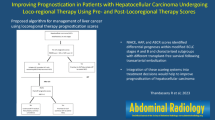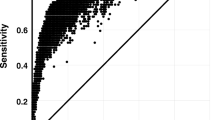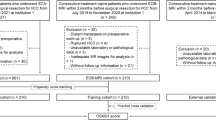Abstract
Objectives
We aimed to evaluate the independent predictive role of baseline imaging biomarkers for overall survival (OS) and transplant-free survival (TFS) in patients with HCC and assess the incremental value of these biomarkers to current staging systems.
Methods
In this retrospective IRB approved study, the clinical, laboratory, and imaging parameters of 304 HCC patients were collected. Cox regression model was utilized to identify the potential predictors of survival. Recursive partitioning test was utilized to identify the optimal ADC cutoff for stratifying patients’ OS. Patients were stratified based on Barcelona Clinic Liver Cancer (BCLC) and Cancer of the Liver Italian Program (CLIP). Binary ADC value (above vs. below the cutoff) and tumor margin (well- vs. ill-defined) were integrated into BCLC and CLIP. OS and TFS was compared for patients based on standard criteria with and without imaging biomarkers.
Results
At baseline, patients with low tumor ADC and well-defined tumor margin (favorable imaging biomarkers) had longer survival, as compared to those with high ADC and ill-defined tumor margin (unfavorable imaging biomarkers) (median OS of 43 months vs. 7 months, respectively) (p < 0.001). Tumor ADC and tumor margin remained strong independent predictors of survival after adjustment for demographics, BCLC and CLIP staging, and tumor burden. Incorporating ADC and tumor margin improved performance of OS prediction by 9% in BCLC group and 6% in CLIP group.
Conclusion
Incorporating ADC and tumor margin to current staging systems for HCC significantly improve prediction of OS and TFS of these criteria.
Key Points
• ADC and tumor margin are predictors of overall survival in HCC patients, independent of clinical, laboratory, and other imaging variables.
• Adding ADC and tumor margin improved the prognostic value of BCLC and CLIP criteria by 9% and 6%, respectively.
• High ADC and ill-defined tumor margin at baseline predicted poor survival, regardless of patient’s liver function and general health status.






Similar content being viewed by others
Abbreviations
- AASLD:
-
American Association for the Study of Liver Diseases
- CT:
-
Computerized tomography
- ADC:
-
Apparent diffusion coefficient
- BCLC:
-
Barcelona Clinic Liver Cancer
- CLIP:
-
Cancer of the Liver Italian Program
- DWI:
-
Diffusion-weighted imaging
- EASL:
-
European Association for the Study of the Liver
- HCC:
-
Hepatocellular carcinoma
- MRI:
-
Magnetic resonance imaging
- MVI:
-
Microscopic vascular invasion
- OS:
-
Overall survival
- PVI:
-
Portal venous invasion
- TFS:
-
Transplant-free survival
References
Petrick JL, Braunlin M, Laversanne M, Valery PC, Bray F, McGlynn KA (2016) International trends in liver cancer incidence, overall and by histologic subtype, 1978-2007. Int J Cancer 139:1534–1545
Petrick JL, Kelly SP, Altekruse SF, McGlynn KA, Rosenberg PS (2016) Future of hepatocellular carcinoma incidence in the United States forecast through 2030. J Clin Oncol 34:1787–1794
European Association for the Study of the Liver (2018) EASL clinical practice guidelines: management of hepatocellular carcinoma. J Hepatol 69:182–236
Marrero JA, Fontana RJ, Barrat A et al (2005) Prognosis of hepatocellular carcinoma: comparison of 7 staging systems in an American cohort. Hepatology 41:707–716
Kaseb AO, Morris JS, Hassan MM et al (2011) Clinical and prognostic implications of plasma insulin-like growth factor-1 and vascular endothelial growth factor in patients with hepatocellular carcinoma. J Clin Oncol 29:3892–3899
Heimbach JK, Kulik LM, Finn RS et al (2018) AASLD guidelines for the treatment of hepatocellular carcinoma. Hepatology 67:358–380
Marrero JA, Kulik LM, Sirlin CB et al (2018) Diagnosis, staging, and management of hepatocellular carcinoma: 2018 Practice Guidance by the American Association for the Study of Liver Diseases. Hepatology 68:723–750
Kim MJ, Lee M, Choi JY, Park YN (2012) Imaging features of small hepatocellular carcinomas with microvascular invasion on gadoxetic acid-enhanced MR imaging. Eur J Radiol 81:2507–2512
Kokabi N, Ludwig JM, Camacho JC, Xing M, Mittal PK, Kim HS (2015) Baseline and early MR apparent diffusion coefficient quantification as a predictor of response of Unresectable hepatocellular carcinoma to doxorubicin drug-eluting bead chemoembolization. J Vasc Interv Radiol 26:1777–1786
Dzik-Jurasz A, Domenig C, George M et al (2002) Diffusion MRI for prediction of response of rectal cancer to chemoradiation. Lancet 360:307–308
Cho HJ, Kim B, Kim HJ et al (2020) Liver stiffness measured by MR elastography is a predictor of early HCC recurrence after treatment. Eur Radiol 30:4182–4192
Padhani AR, Liu G, Koh DM et al (2009) Diffusion-weighted magnetic resonance imaging as a cancer biomarker: consensus and recommendations. Neoplasia 11:102–125
Lee S, Kim SH, Hwang JA, Lee JE, Ha SY (2019) Pre-operative ADC predicts early recurrence of HCC after curative resection. Eur Radiol 29:1003–1012
Wu LF, Rao SX, Xu PJ et al (2019) Pre-TACE kurtosis of ADCtotal derived from histogram analysis for diffusion-weighted imaging is the best independent predictor of prognosis in hepatocellular carcinoma. Eur Radiol 29:213–223
Roayaie S, Blume IN, Thung SN et al (2009) A system of classifying microvascular invasion to predict outcome after resection in patients with hepatocellular carcinoma. Gastroenterology 137:850–855
Chou CT, Chen RC, Lin WC, Ko CJ, Chen CB, Chen YL (2014) Prediction of microvascular invasion of hepatocellular carcinoma: preoperative CT and histopathologic correlation. AJR Am J Roentgenol 203:W253–W259
Yang L, Gu D, Wei J et al (2019) A radiomics nomogram for preoperative prediction of microvascular invasion in hepatocellular carcinoma. Liver Cancer 8:373–386
Chernyak V, Fowler KJ, Kamaya A et al (2018) Liver imaging reporting and data system (LI-RADS) version 2018: imaging of hepatocellular carcinoma in at-risk patients. Radiology 289:816–830
An C, Rakhmonova G, Choi JY, Kim MJ (2016) Liver imaging reporting and data system (LI-RADS) version 2014: understanding and application of the diagnostic algorithm. Clin Mol Hepatol 22:296–307
Schoenfeld DA (1983) Sample-size formula for the proportional-hazards regression model. Biometrics 39:499–503
UCSF Clinical & Translational Sience Institute. Two-group survival analysis sample size calculation given hazard ratio and baseline event rate. Available via https://www.sample-size.net/sample-size-survival-analysis/. Accessed 11/20/2018
Zarghampour M, Fouladi DF, Pandey A et al (2018) Utility of volumetric contrast-enhanced and diffusion-weighted MRI in differentiating between common primary hypervascular liver tumors. J Magn Reson Imaging 48:1080–1090
Wang Z, Chapiro J, Schernthaner R et al (2015) Multimodality 3D tumor segmentation in HCC patients treated with TACE. Acad Radiol 22:840–845
Bonekamp D, Bonekamp S, Halappa VG et al (2014) Interobserver agreement of semi-automated and manual measurements of functional MRI metrics of treatment response in hepatocellular carcinoma. Eur J Radiol 83:487–496
Child CG, Turcotte JG (1964) Surgery and portal hypertension. In: The liver and portal hypertensionMajor Probl Clin Surg. Saunders, Philadelphia, pp 50–64
Pugh RN, Murray-Lyon IM, Dawson JL, Pietroni MC, Williams R (1973) Transection of the oesophagus for bleeding oesophageal varices. Br J Surg 60:646–649
Corona-Villalobos CP, Halappa VG, Bonekamp S et al (2015) Functional magnetic resonance imaging response of targeted tumor burden and its impact on survival in patients with hepatocellular carcinoma. Invest Radiol 50:283–289
Hamstra DA, Rehemtulla A, Ross BD (2007) Diffusion magnetic resonance imaging: a biomarker for treatment response in oncology. J Clin Oncol 25:4104–4109
Mardor Y, Roth Y, Ochershvilli A et al (2004) Pretreatment prediction of brain tumors’ response to radiation therapy using high b-value diffusion-weighted MRI. Neoplasia 6:136–142
Pandey A, Pandey P, Ghasabeh MA et al (2018) Baseline volumetric multiparametric MRI: can it be used to predict survival in patients with unresectable intrahepatic cholangiocarcinoma undergoing transcatheter arterial chemoembolization? Radiology 289:843–853
Thoeny HC, Ross BD (2010) Predicting and monitoring cancer treatment response with diffusion-weighted MRI. J Magn Reson Imaging 32:2–16
Ariizumi S, Kitagawa K, Kotera Y et al (2011) A non-smooth tumor margin in the hepatobiliary phase of gadoxetic acid disodium (Gd-EOB-DTPA)-enhanced magnetic resonance imaging predicts microscopic portal vein invasion, intrahepatic metastasis, and early recurrence after hepatectomy in patients with hepatocellular carcinoma. J Hepatobiliary Pancreat Sci 18:575–585
Gluskin JS, Chegai F, Monti S, Squillaci E, Mannelli L (2016) Hepatocellular carcinoma and diffusion-weighted MRI: detection and evaluation of treatment response. J Cancer 7:1565–1570
Chan JH, Tsui EY, Luk SH et al (2001) Diffusion-weighted MR imaging of the liver: distinguishing hepatic abscess from cystic or necrotic tumor. Abdom Imaging 26:161–165
Ameli S, Shaghaghi M, Aliyari Ghasabeh M et al (2020) Role of baseline volumetric functional MRI in predicting histopathologic grade and patients’ survival in hepatocellular carcinoma. Eur Radiol 30:3748–3758
Ameli S, Shaghaghi M, Ghasabeh MA et al (2020) Does the change in volumetric functional MR metrics post-TACE predict histopathologic grading of hepatocellular carcinoma? Eur Radiol. https://doi.org/10.1007/s00330-020-07052-9
Hu H, Zheng Q, Huang Y et al (2017) A non-smooth tumor margin on preoperative imaging assesses microvascular invasion of hepatocellular carcinoma: a systematic review and meta-analysis. Sci Rep 7:15375
Forner A, Reig M, Bruix J (2018) Hepatocellular carcinoma. Lancet 391:1301–1314
Funding
The authors state that this work has not received any funding.
Author information
Authors and Affiliations
Corresponding author
Ethics declarations
Guarantor
The scientific guarantor of this publication is Dr. Ihab R. Kamel.
Conflict of interest
There authors declare no conflict of interest.
Statistics and biometry
No complex statistical methods were necessary for this paper.
Informed consent
Written informed consent was waived by the Institutional Review Board.
Ethical approval
Institutional Review Board approval was obtained.
Methodology
• retrospective
• cross-sectional study
• performed at one institution
Additional information
Publisher’s note
Springer Nature remains neutral with regard to jurisdictional claims in published maps and institutional affiliations.
This work originated in: Russell H. Morgan Department of Radiology and Radiological Science, Johns Hopkins University, 600 N. Wolfe St, Baltimore, MD 21287
Electronic supplementary material
ESM 1
(DOCX 20 kb)
Rights and permissions
About this article
Cite this article
Aliyari Ghasabeh, M., Shaghaghi, M., Pandey, A. et al. Integrating baseline MR imaging biomarkers into BCLC and CLIP improves overall survival prediction of patients with hepatocellular carcinoma (HCC). Eur Radiol 31, 1630–1641 (2021). https://doi.org/10.1007/s00330-020-07251-4
Received:
Revised:
Accepted:
Published:
Issue Date:
DOI: https://doi.org/10.1007/s00330-020-07251-4




